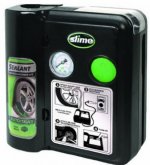I have pasted the text from an article from Consumer Reports. Good info here. They recommend the Continental ContiComfort air inflation kit, the most expensive after market kit, but less expensive than most OEM kits. Interesting that none of the kits tested damaged the TPMS sensors.
Continental ContiComfortKit
Consumer Reports Article
Convenient tire sealants to fix a flat tire
Evaluations show that compressor kits are better than aerosol sealers
Flat tires are always a nuisance. At best, they are inconvenient. At worst, they are costly and potentially dangerous. But there is an assortment of aftermarket emergency flat tire repair products that hold the promise of getting you back on the road quickly, without having to mount a spare tire or call a tow truck.
These types of products have been around for years. They work by pumping a sealant into a flat tire, plugging small punctures from the inside. Sealant kit popularity has been accelerating as the kits become commonplace on new cars, where they are replacing the traditional spare tire for the sake of weight and fuel consumption savings.
To assess how the latest products work, our tire team took a break from its schedule of testing almost 500 tires this year to evaluate two types of repair kits:
Pressurized-can sealers ($7.50 to $10), such as the ubiquitous Fix-A-Flat, are one-time-use products that have a dispensing tube that screws to a tire’s air-inflation valve. These sealers can patch a hole and inflate the tire.
Tire-sealant kits ($20 to $80) combine a portable 12-volt air compressor and a replaceable container of sealant. More and more new cars supply this kind of kit in lieu of a spare tire.
Despite their roles, these products are not spare tires in a can. They should only be used for tires that are technically repairable, by sealing a small hole only in the tread, and with the understanding that the fix is strictly temporary. No attempt should be made to repair a hole larger than 6 mm in diameter or a cut or hole in a sidewall. With that kind of damage, your only option is replacing the tire.
If you use a tire sealant, you should get the tire professionally repaired or replaced as quickly as possible—typically within 100 miles or as directed by the product.
Sealants coat the inside of the tire and wheel with a messy residue, which a tire shop has to clean out, possibly causing extra expense. They can potentially gum up the tire-pressure monitor sensor (TPMS), if so equipped, risking erroneous readings. But in our tests, we had no sensor become inoperable. Typically the sensors needed to cleaned after a sealant was used. Some products specifically claim that they are TPMS safe.
How we tested: We conducted two rounds of tests, puncturing tires first with a small nail, about 1.5 mm in diameter, and then a larger one of about 4.2 mm in diameter, using a Chevrolet Spark with relatively small, 15-inch all-season tires.
Since the pressurized cans could only manage to inflate the 15-inch tires to 18 psi, we topped up those tires to their recommended 40 psi using a large compressor before checking their ability to maintain pressure. We rechecked the pressure after an overnight sit, and repeated the process over several days while driving a minimum of 100 miles on the patched tire.
Results: All the sealants successfully plugged the small nail holes, maintaining 40 psi for a week and at least 100 miles of driving.
But the pressurized can products had trouble with the larger nail hole. Two of the products could not seal the 15-inch tire on the Chevrolet Spark. A third product did, but this one could not seal a different tire with the same size hole. In any case, if sealed, the tire was only partially inflated and needed to be topped off to attain the recommended pressure. That hole, made by a nail slightly less than 3/16-inch diameter, seemed to be stretching the limits of these products. The compressor-and-sealant kits all did fine with this challenge.
Tire-fix compressor kits
Continental ContiComfortKit
With the full kits, you plug a lightweight compressor into the car’s 12-volt lighter, or accessory power socket, and screw an included tube onto the flat tire’s inflation valve. With most, the compressor forces air through a container of tire sealant into the flat tire.
Unlike the pressurized can flat-fixers, these kits can pump a fully flat tire up to its recommended pressure. And since the sealant isn’t pressurized before you use it, you can keep the kit in your car. (Pressurized cans risk rupturing if left in a hot car.)
Another plus is that when you’re not using it to pump sealant into a flat tire, the compressor can inflate other car tires, yard equipment, boat trailers, and so forth.
Continental ContiComfortKit ($79)
Though the costliest kit we tested, the Continental was the slickest.
Performance: The compressor did its job relatively quickly.
Notable features: Built-in air gauge, reflector, and small light. The ContiComfortKit came with enough sealant to repair a wide range of tires, as spelled-out in an included size chart. Thorough instructions.
Slime Safety Spair
Slime Safety Spair ($39.77) and Fix-A-Flat Ultimate ($29.97)
These two appear practically identical beneath their labels.
Performance: Took longer than the Continental to inflate a tire. Easy to use.
Notable features: Built-in air gauge and lamp.
AirMan ResQ Pro ($49.95)
Somewhat bulky but neatly packaged.
Performance: Took longer than the Continental to inflate a tire. Easy to use.
Notable features: Built-in air gauge and small light. Adaptors for sports equipment. Convenient carry handle.
Slime Smart Spair ($19)
Inexpensive but far more troublesome to use than the others. Must remove deflated tire’s valve core with a supplied tool, pour sealant into tire from squeeze bottle, reinsert valve core, and inflate tire. Valve-core tool is flimsy plastic.
Performance: Typically took a longer process to fix a tire than other systems.
Notable features: Air gauge. Adaptors for other inflatable gear.
Pressurized-can sealants
Slime Quick Spair
The biggest advantage of pressurized-can sealers is that they’re widely available and cheap: $7 to $10 for a can designed for most car tires, a little more for 18- and 20-oz cans designed for larger-volume pickup-truck and SUV tires.
The 16-oz size doesn’t fully inflate even a small 15-inch tire. One product, the Prestone TireJack, suggests using two cans on tires larger than 14-inch. We can not recommend using multiple cans or a truck-sized can on a passenger tire as there is the risk of overinflating the tire, and you should not mix one sealant product with another. If you are considering one of these products, you’ll need a pressure gauge and a compressor to set the pressure to the recommended vehicle setting. Some labels say they can be stored in a car’s trunk, but not where temperatures may exceed 120 degrees Fahrenheit. We don’t think in-car storage is very safe, even in the trunk.
Fix-A-Flat ($7.49, 16-oz)
Fixed small and large nail holes in the 15-inch tire, but it didn’t hold pressure when trying to fix the larger-nail puncture on a 16-inch tire on our Nissan Altima. (Fix-A-Flat doesn’t define a specific tire size range, just that it works on standard-sized car tires.) It was only able to inflate standard tire to less than half of 40-psi recommended pressure on our Spark.
Slime Quick Spair ($9.95, 16-oz)
This aerosol was able to repair the small nail hole, but it couldn’t maintain pressure with a larger puncture. Quick Spair was only able to inflate the Spark’s tire to less than half of 40-psi recommended pressure.
Prestone TireJack ($10.18, 18-oz)
The small nail hole was no problem but the Prestone product couldn’t maintain pressure with a larger puncture. Like the others, it was only able to inflate the Spark’s tire to less than half of 40-psi recommended pressure.
Bottom line
Fix-A-Flat
In a pinch, a pressurized can sealant may be able to fix a small hole and allow the car to limp to the tire store for a full repair or tire replacement. The better investment is a full kit, which has the ability to fix and inflate a tire to the recommended pressure, not to mention they can be safely stowed in the car, even a hot car. On a vacation, or during a busy day, a tire repair kit with a compressor would better allow you to continue your routine. They cost more, but based on our experience, the price is worthwhile.
In the end, having a true spare tire onboard is best. Even with new cars that have omitted the spare to reduce weight, and thereby incrementally bolster fuel economy, often the manufacturer has a means for fitting a spare in the trunk. It is worth asking when shopping for a new car. Just remember to periodically check the tire pressure in the spare to ensure it is ready to be used, should the unfortunate occasion arise.
Sent from my iPad using Tapatalk







